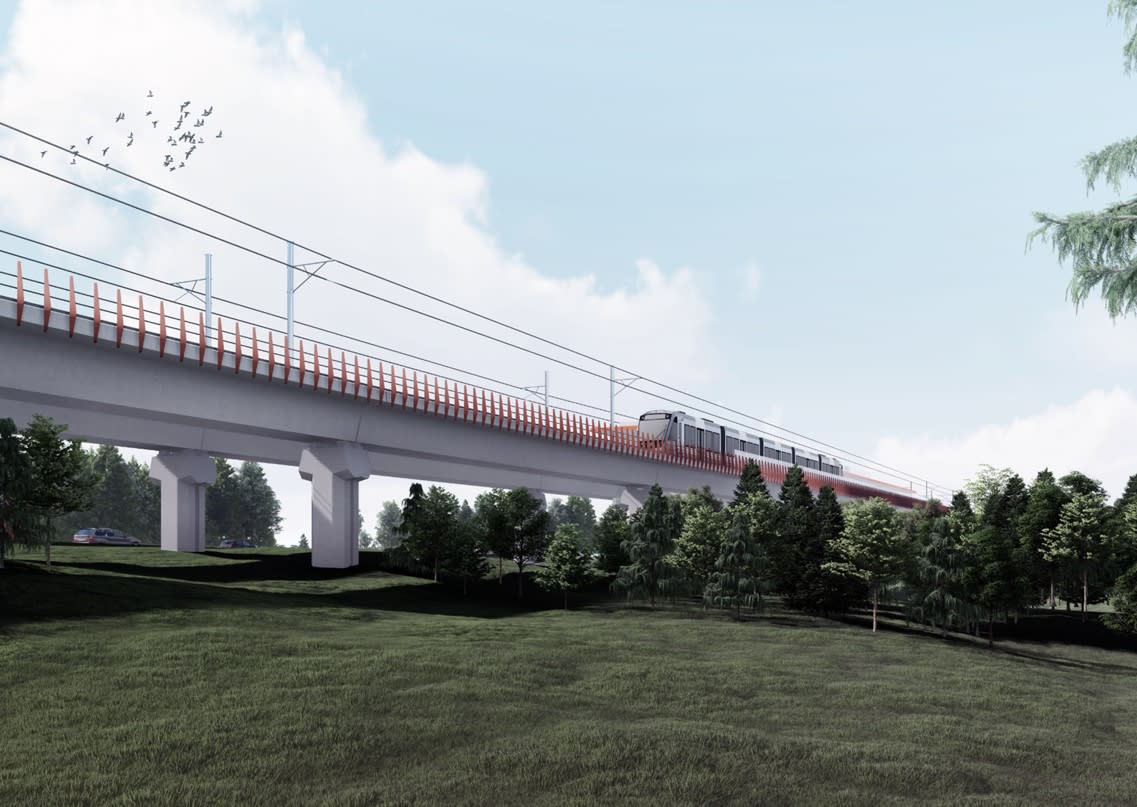Share
Elevating transit: A guideway across the Humber
The ECWE's elevated guideway will connect communities across the Humber River.
Jan 9, 2025
Work is ramping up on the Eglinton Crosstown West Extension, which will extend the Eglinton Crosstown LRT 9.2 kilometres farther west, bringing 37,500 more residents within walking distance of transit, and connecting them to UP Express and GO rail services, and TTC, MiWay and GO bus services. The line will feature seven new stations.
While the extension will run mainly underground, preparations are underway for an elevated section called a guideway, which will run across the Humber River Valley on the north side of Eglinton Avenue from just east of Jane Street to just west of Scarlett Road.
Guiding the way across the valley
A rendering of the elevated guideway. (Metrolinx image)
Building an elevated guideway over the Humber River calls for some impressive engineering: it will span 1.5 kilometres across the river valley, reaching 21 metres at its highest point.
The structure needs to support the weight of vehicles and passengers traveling on it, as well as the various weather conditions and events expected in the area, including, wind, rain, ice and snow.
The first step is to dig deep into the geology. Geotechnical investigations measure the strength and stiffness of the soil and rock, to determine how best to handle the stress.
Then, we need to map what’s below the surface in three dimensions, to locate any electrical, sewer, water or other utilities needed to relocate or build around.
The guideway’s piers will be built outside the river, allowing the elevated guideway to span the entire width of the river and avoid any in-water construction. To help stabilize the Humber’s west bank, we’ll build a wall made of reinforced concrete columns into the bank. This will ensure it can handle the weight of the guideway above. The soft, wet ground near the river calls for solid foundations called caissons that extend up to 33 metres into the earth, reaching into solid rock for added strength. Large poles called monopiles are drilled to keep water out of the caissons, reducing the environmental impacts of construction.
Working with communities on restoration
Tree planting in Fergy Brown Park. (Metrolinx Image)
During construction, we’ll rely on a comprehensive landscape restoration strategy to ensure we leave the ecosystem in the same or better shape than how we found it. This strategy sets the stage for how parks, open spaces, trails and project lands will be restored, and was developed in consultation with local communities and other key stakeholders. We’re also employing environmental protection measures, like installing bat habitat boxes to provide shelter during their roosting season, and fences to keep unwanted wildlife from sensitive areas. In a well-established and growing region, some trees need to be removed to make room for the new transit line. To offset these removals, Metrolinx follows a detailed, science-based plan for planting new trees and keeping the region green.
We’ll replace each tree we need to remove with at least three new ones and replace woodlands we disturb with up to eight times as much new woodland, by area. Work has already begun on planting 8,500 new trees in the areas to offset the 1,300 we need to remove, about half of which are from invasive species.
What’s next?
Since the contract to design and build the guideway was awarded in late 2023, teams have been working to prepare the site for the start of major construction, scheduled to begin this year.
With work underway to prepare the site, we’re engaged in minimizing the impact on residents by controlling noise, vibration and air quality, using sensors along the length of the project. To keep dust to a minimum, we’ll water the grounds regularly, and street sweepers will ensure excessive mud doesn’t get tracked out of the construction site.
Being a good neighbour also means supporting the communities in which we work; learn more here.
All this ensures we build the future of transit in a way that respects residents and the environment.
To keep up with the latest news on the project, follow the Eglinton Crosstown West Extension on Instagram, X and Facebook, and sign up for the project newsletter.
Questions about the project? Reach out to the community engagement team or stop by our community office at 326 Scarlett Road.
by Mark Farmer Senior Advisor Digital Communications
